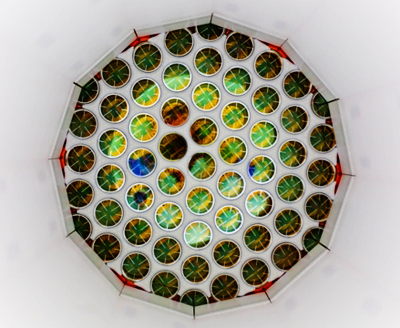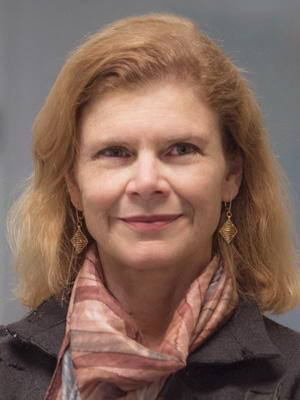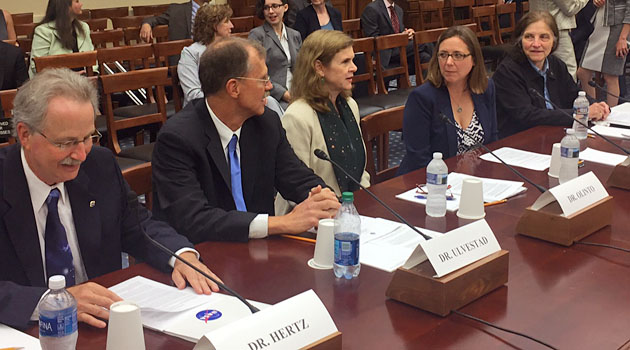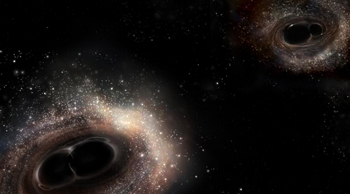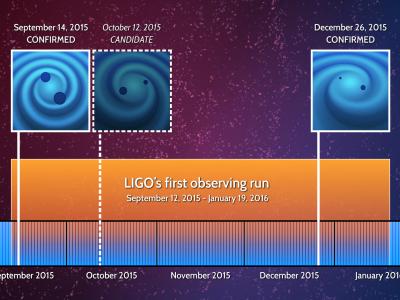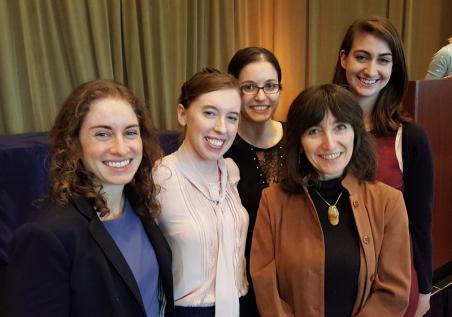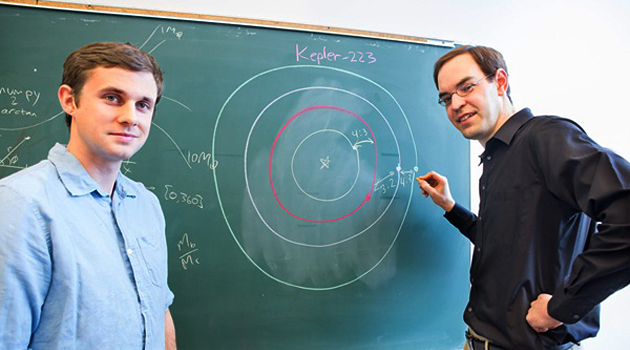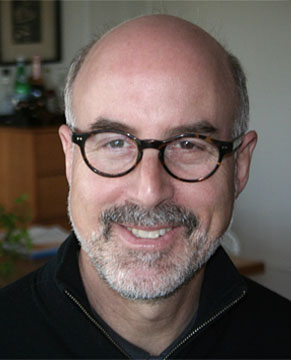 |
 |
 |
 |
 |
 |
 |
 |
 |
 |
 |
 |
|
News
|
Department in the News: 2016
Astronomers discover dark past of planet-eating 'Death Star' December 15, 2016 Death star HIP68468, a twin star to the sun about 300 light-years away, may have swallowed one or more of its planets, based on lithium and refractory elements recently discovered near its surface. UChicago News, by Greg BorzoIllustration by Gabi Perez / Instituto de Astrofísica de Canarias Click on the image to enlarge Solar twin could hold clues to planetary formation An international team of scientists, including researchers from the University of Chicago, has made the rare discovery of a planetary system with a host star similar to Earth's sun. Especially intriguing is the star's unusual composition, which indicates it ingested some of its planets. "It doesn't mean that the sun will 'eat' the Earth any time soon," said Jacob Bean, assistant professor of astronomy and astrophysics at UChicago and co-author of an Astronomy & Astrophysics article on the research. "But our discovery provides an indication that violent histories may be common for planetary systems, including our own." Unlike the artificial planet-destroying Death Star in the movie "Star Wars," this natural version could provide clues about how planetary systems evolve over time. Astronomers discovered the first planet orbiting a star other than the sun in 1995. Since then, more than two thousand exoplanets have been identified. Rare among them are planets that orbit a star similar to Earth's sun. Due to their extreme similarity to the sun, these so-called solar twins are ideal targets for investigating the connections between stars and their planets. Bean and his colleagues studied star HIP68468, which is 300 light years away, as part of a multi-year project to discover planets that orbit solar twins. It's tricky to draw conclusions from a single system, cautioned Megan Bedell, a UChicago doctoral student who is co-author of the research and the lead planet finder for the collaboration. She said the team plans "to study more stars like this to see whether this is a common outcome of the planet formation process." Related: Department members: Jacob L. Bean Department students: Megan Bedell Daniel Holz: Gravitational Waves October 13, 2016 The Good Stuff In 2015 scientists working at the Laser Interferometer Gravitational-Wave observatory, or LIGO, detected gravitational waves for the first time. But how did they do it? What is a gravitational wave? And why is confirming something that Albert Einstein predicted a hundred years ago one of the greatest scientific achievements of the past century? Related: Department members: Daniel E. Holz Department students: Hsin-Yu Chen Scientific projects: Laser Interferometer Gravitational-wave Observatory Why is this star dimming? Astronomers still don't know October 6, 2016 This artist's conception shows a star behind a shattered comet. (NASA/JPL-Caltech) Fox News Science, by Rob VergerClick on the image to enlarge A strange star in our galaxy has officially become even more enigmatic: According to data collected by NASA's Kepler space telescope, the star mysteriously dimmed over a period of a few years. The star is called KIC 8462852, and it was already on scientists' radar for fluctuations in its brightness. So two astronomers decided to study it more carefully, using images from Kepler. They discovered that from 2009 to 2012, the star's brightness declined by just under 1 percent. Then, over a time period of six months, its brightness plunged by 2 percent. While news of their discovery first surfaced in August, their work has now been accepted for publication in an astronomy journal, the Carnegie Institution for Science announced on Monday. "The steady brightness change in KIC 8462852 is pretty astounding," Ben Montet, an astronomer and fellow at the University of Chicago, said in a statement. "Our highly accurate measurements over four years demonstrate that the star really is getting fainter with time. It is unprecedented for this type of star to slowly fade for years, and we don't see anything else like it in the Kepler data." Montet is coauthor on the new study about the star, forthcoming in the Astrophysical Journal. Related: Department members: Benjamin Montet Physics Confronts Its Heart of Darkness September 1, 2016 Scientific American, by Lee Billings Cracks are showing in the dominant explanation for dark matter. Is there anything more plausible to replace it? Physics has missed a long-scheduled appointment with its future - again. The latest, most sensitive searches for the particles thought to make up dark matter - the invisible stuff that may comprise 85 percent of the mass in the cosmos - have found nothing. Called WIMPs (weakly interacting massive particles), these subatomic shrinking violets may simply be better at hiding than physicists thought when they first predicted them more than 30 years ago. Alternatively, they may not exist, which would mean that something is woefully amiss in the underpinnings of how we try to make sense of the universe. Many scientists still hold out hope that upgraded versions of the experiments looking for WIMPs will find them but others are taking a second look at conceptions of dark matter long deemed unlikely. Whatever dark matter is, it is not accounted for in the Standard Model of particle physics, a thoroughly-tested "theory of almost everything" forged in the 1970s that explains all known particles and all known forces other than gravity. Find the identity of dark matter and you illuminate a new path forward to a deeper understanding of the universe - at least, that is what physicists hope. WIMPs would get their gravitational heft from being somewhere between one and a thousand times the mass of a proton. Their sole remaining connection to our familiar world would be through the weak nuclear force, which is stronger than gravity but only active across tiny distances on the scale of atomic nuclei. If they exist, WIMPs should surround us like an invisible fog, their chances of interacting with ordinary matter so remote that one could pass through light-years of elemental lead unscathed. Undaunted, experimentalists have spent decades devising and operating enough cleverly named WIMP detectors to overflow your average can of alphabet soup. (CDEX, CDMS, CoGeNT, COUPP and CRESST are just the most notable examples that start with the letter C.) The delicate work of detecting any weak, rare and fleeting interactions of WIMPs with atoms requires isolation and solitude, confining most detectors to caverns, abandoned mines and other outlier subterranean spaces. One of the latest null results in the search for WIMPs came from the Large Underground Xenon (LUX) experiment, a third of a ton of liquid xenon held at a frosty -100 degrees Celsius inside a giant water-filled tank buried one and a half kilometers beneath the Black Hills of South Dakota. There, shielded from most sources of contaminating noise, researchers have spent more than a year's worth of time looking for flashes of light emanating from WIMPs striking xenon nuclei. On July 21 they announced they had seen none. The next disappointment came on August 5 from the most powerful particle accelerator ever built: CERN's Large Hadron Collider (LHC) near Geneva, Switzerland. In 2012 after it found the Higgs boson - the Standard Model’s long-predicted final particle that imbues others with mass - many theorists believed the next blockbuster result from the LHC would be a discovery of how the Higgs (or other hypothesized particles very much like it) helps produce the WIMPs thought to suffuse the cosmos. Since spring 2015 the LHC has been pursuing these ideas by smashing protons together at unprecedentedly high energies at rates of up to a billion per second, pushing into new frontiers of particle physics. Early on, two independent teams had spied a telltale anomaly in the subatomic wreckage, an excess of energy from proton collisions that hinted at new physics perhaps produced by WIMPs (or, to be fair, many additional exotic possibilities). Instead, as the LHC smashed more protons and collected more data, the anomaly fizzled out, indicating it had been a statistical fluke. Taken together, these two null results are a double-edged sword for dark matter. On one hand, their new constraints on the plausible masses and interactions of WIMPs are priming plans for next-generation detectors that could offer better chances of success. On the other, they have ruled out some of the simplest and most cherished WIMP models, raising fresh fears that the long-postulated particles might be a multidecadal detour in the search for dark matter. Edward "Rocky" Kolb, a cosmologist now at the University of Chicago who in the 1970s helped lay the foundations for the generations of WIMP hunts to come, declared the 2010s "the decade of the WIMP" but now admits the search has not gone as planned. "We are now more in the dark about dark matter than we were five years ago," he says. So far, Kolb says, most theorists have responded by "letting a thousand WIMPs bloom," creating ever-more baroque and exotic theories to explain how WIMPs have managed to dodge all our detectors. There is, of course, another possibility - that WIMPs are not the solution to dark matter we should be looking for. "WIMPs emerged as a simple, elegant, compelling explanation for a complex phenomenon," Kolb says. "And for every complex phenomenon there is a simple, elegant, compelling explanation that is wrong." Related: Department members: Edward ''Rocky'' W. Kolb James W. Cronin, Nobel laureate and pioneering physicist, 1931-2016 August 27, 2016 UChicago News, by Steve Koppes Scholar remembered for groundbreaking research on particle physics and cosmic rays James W. Cronin, a pioneering scientist who shared the Nobel Prize in physics in 1980 for his groundbreaking work on the laws governing matter and antimatter and their role in the universe, died Aug. 25 in Saint Paul, Minn. He was 84. Cronin, SM'53, PhD'55, spent much of his career at the University of Chicago, first as a student and then a professor. A University Professor Emeritus of Physics and Astronomy & Astrophysics, he was remembered this week as a mentor, collaborator and visionary. "He inspired us all to reach further into the unknown with deep intuition, solid scientific backing and poetic vision," said Angela Olinto, the Homer J. Livingston Distinguished Service Professor in Astronomy and Astrophysics. "He accepted his many recognitions and accolades with so much humility that he encouraged many generations to follow his vision." Edward "Rocky" Kolb, dean of the Physical Sciences Division and the Arthur Holly Compton Distinguished Service Professor in Astronomy and Astrophysics, described Cronin as “a person of real honesty and integrity who was a mentor and friend to so many people." "Just like in basketball, there are good players in science, but the greatest players are the ones who make the people around them better. Jim was that great player," Kolb said. Cronin’s research that resulted in the Nobel Prize came in 1964 while he was working with Val Fitch at the Brookhaven National Laboratory. The two scientists, who were Princeton University professors at the time, observed the first example of nature's preference for matter over antimatter. Without the phenomenon, which physicists refer to as charge-parity violation, no matter would exist in the universe. Cronin and Fitch studied the short-lived subatomic particles that appeared after the collision of accelerated protons and the nucleus of an atom. They observed indirect charge-parity violation, which is the unbalanced mixing of neutral subatomic kaon particles with their charged antiparticles. Called the Fitch-Cronin effect, the finding showed that some physical laws are violated when the direction of time is reversed. It also lent support for the big bang theory of the universe's origin. Cronin later in his career shifted his focus, becoming co-leader of the Pierre Auger Project. The $50 million international collaboration of 250 scientists across 16 nations focused on the mysterious sources of rare but extremely powerful cosmic rays that periodically bombard Earth. The project led to the creation of the Auger Observatory, which consists of a vast array of cosmic-ray detectors in Argentina. "It was 25 years ago since Jim and I first conceived the idea of what became the Auger Collaboration. It was definitely a great partnership as we drummed up financial and scientific support for the collaboration," said Alan Watson, emeritus professor of physics at the University of Leeds and a fellow of the Royal Society. The collaboration has made definitive measurements on the energy spectrum of cosmic rays, on the patterns of their arrival directions, and on their mass compositions. It also has conducted particle physics research, measuring phenomena that far exceed the energies of the Large Hadron Collider. "It's been an outstanding success, and it's still going strong," Watson said. Drawing inspiration from Fermi Cronin was born on Sept. 29, 1931, in Chicago, while his father was a graduate student in classical languages and literatures at the University of Chicago. The younger Cronin received a bachelor's from Southern Methodist University in 1951 before returning to the University of Chicago as a National Science Foundation Fellow to earn his master's and doctoral degrees. Cronin met his first wife, Annette Martin, while both were students at the University. She died in 2005, and Cronin married Carol McDonald (nee Champlin) in late 2006. Cronin began his scientific career at Brookhaven before becoming a member of the physics faculty at Princeton in 1958. In 1971, he joined the University of Chicago, where he was appointed the University Professor of Physics. He became University Professor Emeritus of Physics and Astronomy & Astrophysics in 1997. Cronin shared a birthdate with Prof. Enrico Fermi, who earned the Nobel Prize in Physics in 1938. Cronin, who knew Fermi from his graduate school days at UChicago, organized a symposium in 2001 to mark the 100th anniversary of Fermi's birth, and was editor of the resulting book, Fermi Remembered. It included contributions from seven Nobel Prize recipients and many other scientists who studied under or worked with Fermi at UChicago. "What's significant about Fermi is if you look through his career, he never just did the same thing. He kept moving on to new scientific challenges," Cronin once said of Fermi. The same statement also could be applied to Cronin and his research shift from high-energy physics to ultra-high-energy cosmic rays. Cronin's honors include the University of Chicago Alumni Medal (2013), election as a foreign member of the Royal Society of London (2007), Distinguished Graduate Award of SMU's Dedman College (2004), Legion d’honneur of France (2001), National Medal of Science (1999), University of Chicago's Quantrell Award for Excellence in Undergraduate Teaching (1994), Laureate of Lincoln Academy of Illinois (1981), Ernest Lawrence Memorial Award for outstanding contributions in the field of atomic energy (1977), John Price Wetherill Medal of the Franklin Institute (1975) and the Research Corporation Award (1968). In 1990 Cronin delivered the Ryerson Lecture, which provides an opportunity each year for a distinguished faculty member to address the UChicago community on significant aspects of his or her research. He was a member of the National Academy of Sciences, American Academy of Arts and Sciences, American Physical Society, American Philosophical Society, Accademia Nazionale dei Lincei of Italy, Mexican Academy of Sciences and the Russian Academy of Sciences. Cronin also had received honorary doctorates from l'Universite Pierre et Marie Curie, University of Leeds, Universite de Franche Conte, Novo Gorica Polytechnique of Slovenia, University of Nebraska, the University of Santiago de Compostela, the Colorado School of Mines, and the Karlsruhe Institute of Technology. Cronin served as international chair of the College de France in 1999-2000. Cronin is survived by his wife, Carol; daughter, Emily Grothe; son, Daniel Cronin; and six grandchildren: James, Cathryn, Caroline, Meredith, Alex and Marlo. A daughter, Cathryn Cranston, died in 2011. Related: Department members: James W. Cronin, Edward ''Rocky'' W. Kolb, Angela V. Olinto Scientific projects: Pierre Auger Observatory Angela Olinto received distinguished service professorship July 21, 2016 Angela V. Olinto, the Homer J. Livingston Distinguished Service Professor in Astronomy & Astrophysics and the College UChicago NewsFaculty members recognized with named, distinguished service professorships Ten faculty members have received named professorships or have been named distinguished service professors. Luc Anselin, John R. Birge, John List and Angela Olinto received distinguished service professorships; and Ethan Bueno de Mesquita, Michael Franklin, Christopher Kennedy, Jason Merchant, Haresh Sapra and Nir Uriel received named professorships. Angela Olinto has been named the Homer J. Livingston Distinguished Service Professor in Astronomy & Astrophysics and the College. Olinto has made important contributions to the physics of quark stars, inflationary theory, cosmic magnetic fields and particle astrophysics. Her research interests span theoretical astrophysics, particle and nuclear astrophysics, and cosmology. She has focused much of her recent work on understanding the origins of the highest-energy cosmic rays and neutrinos. Olinto is an elected fellow of the American Association for the Advancement of Science for her distinguished contributions to the field of astrophysics, particularly exotic states of matter and extremely high-energy cosmic ray studies at the Pierre Auger Observatory in Argentina. She now leads the International collaboration of the Extreme Universe Space Observatory mission that will fly in a NASA super pressure balloon in 2017 and will be first to observe tracks of ultra-energy particles from above. She also is a fellow of the American Physical Society and has received the Chaire d’Excellence Award of the French Agence Nationale de Recherche. Olinto has received the Llewellyn John and Harriet Manchester Quantrell Award for Excellence in Undergraduate Teaching, as well as the Faculty Award for Excellence in Graduate Teaching and Mentoring. Olinto joined the UChicago faculty in 1996. Related: Department members: Angela V. Olinto Angela Olinto: the 114th Congress Hearing - Astronomy, Astrophysics, and Astrobiology July 12, 2016 Committee on Science, Space and Technology, 114th Congress Joint Space Subcommittee and Research and Technology Subcommittee Hearing - Astronomy, Astrophysics, and Astrobiology Tuesday, July 12, 2016 - 10:00am Opening Statements - Space Subcommittee Chairman Brian Babin (R-Texas) - Research and Technology Subcommittee Chairwoman Barbara Comstock (R-Va.) - Chairman Lamar Smith (R-Texas) Witnesses
Related: Department members: Angela V. Olinto Simulations foresee hordes of colliding black holes in observatory's future June 28, 2016 New research predicts that LIGO will detect gravitational waves generated by many more merging black holes in coming years. UChicago News, by Steve KoppesCourtesy of LIGO/A. Simonnet New calculations predict that the Laser Interferometer Gravitational wave Observatory (LIGO) will detect approximately 1,000 mergers of massive black holes annually once it achieves full sensitivity early next decade. The prediction, published online June 22 in the journal Nature, is based on computer simulations of more than a billion evolving binary stars. The simulations are based on state-of-the-art modeling of the physics involved, informed by the most recent astronomical and astrophysical observations. "The main thing we find is that what LIGO detected makes sense," said Daniel Holz, associate professor in physics and astronomy at the University of Chicago and a co-author of the Nature paper. The simulations predict the formation of black-hole binary stars in a range of masses that includes the two already observed. As more LIGO data become available, Holz and his colleagues will be able to test their results more rigorously. The paper's lead author, Krzysztof Belczynski of Warsaw University in Poland, said he hopes the results will surprise him, that they will expose flaws in the work. Their calculations show, for example, that once LIGO reaches full sensitivity, it will detect only one pair of colliding neutron stars for every 1,000 detections of the far more massive black-hole collisions. "Actually, I would love to be proven wrong on this issue. Then we will learn a lot," Belczynski said. Forming big black holes The new Nature paper, which includes co-authors Tomasz Bulik of Warsaw University and Richard O'Shaughnessy of the Rochester Institute of Technology, describes the most likely black-hole formation scenario that generated the first LIGO gravitational-wave detection in September 2015. That detection confirmed a major prediction of Albert Einstein's 1915 general theory of relativity. The paper is the most recent in a series of publications, topping a decade of analyses where Holz, Belczynski and their associates theorize that the universe has produced many black-hole binaries in the mass range that are close enough to Earth for LIGO to detect. "Here we simulate binary stars, how they evolve, turn into black holes and eventually get close enough to crash into each other and make gravitational waves that we would observe," Holz said. The simulations show that the formation and evolution of a typical system of binary stars results in a merger of similar masses, and after similarly elapsed times, to the event that LIGO detected last September. These black hole mergers have masses ranging from 20 to 80 times more than the sun. LIGO will begin recording more gravitational-wave-generating events as the system becomes more sensitive and operates for longer periods of time. LIGO will go through successive upgrades over the coming years, and is expected to reach its design sensitivity by 2020. By then, the Nature study predicts that LIGO might be detecting more than 100 black hole collisions annually. LIGO has detected big black holes and big collisions, with a combined mass greater than 30 times that of the sun. These can only be formed out of big stars. "To make those you need to have low metallicity stars, which just means that these stars have to be relatively pristine," Holz said. The Big Bang produced mainly hydrogen and helium, which eventually collapsed into stars. Forging metals As these stars burned they forged heavier elements, which astronomers call "metals." Those stars with fewer metals lose less mass as they burn, resulting in the formation of more massive black holes when they die. That most likely happened approximately two billion years after the Big Bang, before the young universe had time to form significant quantities of heavy metals. Most of those black holes would have merged relatively quickly after their formation. LIGO would be unable to detect the ones that merged early and quickly. But if the binaries were formed in large enough numbers, a small fraction would survive for longer periods and would end up merging 11 billion years after the Big Bang (2.8 billion years ago), recently enough for LIGO to detect. "That's in fact what we think happened," Holz said. Statistically speaking, "it's the most likely scenario." He added, however, that the universe continues to produce binary stars in local, still pristine pockets of low metallicity that resemble conditions of the early universe. "In those pockets you can make these big stars, make the binaries, and then they'll merge right away and we would detect those as well." Belczynski, Holz and collaborators have based their simulations on what they regard as the best models available. They assume "isolated formation," which involves two stars forming in a binary, evolving in tandem into black holes, and eventually merging with a burst of gravitational wave emission. A competing model is "dynamical formation," which focuses on regions of the galaxy that contain a high density of independently evolving stars. Eventually, many of them will find each other and form binaries. "There are dynamical processes by which those black holes get closer and closer and eventually merge," Holz said. Identifying which black holes merged under which scenario is difficult. One potential method would entail examining the black holes' relative spins. Binary stars that evolved dynamically are expected to have randomly aligned spins; detecting a preference for aligned spins would be clear evidence in favor of the isolated evolutionary model. LIGO is not yet able to precisely measure black hole spin alignment, "but we're starting to get there," Holz said. "This study represents the first steps in the birth of the entirely new field of gravitational wave astronomy. We have been waiting for a century, and the future has finally arrived." Citation: "The first gravitational-wave source from the isolated evolution of two stars in the 40-100 solar mass range," by Krzysztof Belczynski, Daniel E. Holz, Tomasz Bulik, and Richard O’Shaughnessy," Nature, Vol. 534, pp. 512-515, June 23, 2016, doi:10.1038/nature18322. Related: Department members: Daniel E. Holz Scientific projects: Laser Interferometer Gravitational-wave Observatory Gravitational waves detected from second pair of colliding black holes June 16, 2016 This illustration shows the dates for two confirmed gravitational wave detections by LIGO; and one candidate detection, which was too weak to unambiguously confirm. All three events occurred during the first four-month run of Advanced LIGO - the upgraded, more-sensitive version of the facilities. UChicago NewsIllustration by LIGO Collaboration At 9:38:53 CST on Dec. 25, 2015, scientists observed gravitational waves - ripples in the fabric of spacetime - for the second time. The gravitational waves were detected by both of the twin Laser Interferometer Gravitational-Wave Observatory detectors, located in Livingston, La., and Hanford, Wash. University of Chicago scientists led by Daniel Holz, assistant professor in physics and astronomy, are members of the LIGO collaboration. The LIGO observatories are funded by the National Science Foundation, and were conceived, built and are operated by the California Institute of Technology and the Massachusetts Institute of Technology. The discovery, accepted for publication in the journal Physical Review Letters, was made by the LIGO Scientific Collaboration and the Virgo Collaboration using data from the two LIGO detectors. The LIGO detectors operated for approximately four months late last year, yielding about 50 days of data. An analysis of the first 16 days of data yielded the event that the LIGO Collaboration announced in February 2016. Black holes events "Now we’ve analyzed the rest of the data, and we have another event that’s particularly interesting," Holz said. "It's not quite as loud as the first one, but it's quite beautiful in its own way. The event is composed of smaller black holes, and at least one is spinning. This marks the official turning point from 'detector' to 'observatory.'" Gravitational waves carry information about their origins and about the nature of gravity that cannot otherwise be obtained, and physicists have concluded that these gravitational waves were produced during the final moments of the merger of two black holes - 14 and 8 times the mass of the sun - to produce a single, more massive spinning black hole that is 21 times the mass of the sun. "It is very significant that these black holes were much less massive than those observed in the first detection," said Gabriela Gonzalez, LIGO Scientific Collaboration spokesperson and professor of physics and astronomy at Louisiana State University. "Because of their lighter masses compared to the first detection, they spent more time - about one second - in the sensitive band of the detectors. It is a promising start to mapping the populations of black holes in our universe." During the merger, which occurred approximately 1.4 billion years ago, a quantity of energy roughly equivalent to the mass of the sun was converted into gravitational waves. The detected signal comes from the last 27 orbits of the black holes before their merger. Based on the arrival time of the signals - with the Livingston detector measuring the waves 1.1 milliseconds before the Hanford detector - the position of the source in the sky can be roughly determined. The first detection of gravitational waves, announced on Feb. 11, 2016, was a milestone in physics and astronomy: It confirmed a major prediction of Albert Einstein's 1915 general theory of relativity, and marked the beginning of the new field of gravitational wave astronomy. Both discoveries were made possible by the enhanced capabilities of Advanced LIGO, a major upgrade that increases the sensitivity of the instruments compared to the first-generation LIGO detectors, enabling a large increase in the volume of the universe probed. 'With the advent of Advanced LIGO, we anticipated researchers would eventually succeed at detecting unexpected phenomena, but these two detections thus far have surpassed our expectations,' said NSF Director France A. Cordova. "NSF's 40-year investment in this foundational research is already yielding new information about the nature of the dark universe." Advanced LIGO's next data-taking run will begin this fall. By then, further improvements in detector sensitivity are expected to allow LIGO to reach as much as 1.5 to 2 times more of the volume of the universe. The Virgo detector is expected to join in the latter half of the coming observing run. LIGO research is carried out by the LIGO Scientific Collaboration, a group of more than 1,000 scientists from universities around the United States and in 14 other countries. More than 90 universities and research institutes in the LSC develop detector technology and analyze data; approximately 250 students are strong contributing members of the collaboration. Virgo research is carried out by the Virgo Collaboration, consisting of more than 250 physicists and engineers belonging to 19 different European research groups. Related: Department members: Daniel E. Holz Scientific projects: Laser Interferometer Gravitational-wave Observatory Wendy Freedman Named 2016 Woman in Space Science May 23, 2016 Professor Wendy Freedman (second from right) with PSD grad students Laura Kreidberg, Megan Bedell, Maya Fishbach, and Nora Shipp UChicago NewsClick on the image to enlarge On Thursday, May 12, Chicago's Adler Planetarium presented the 2016 Women in Space Science Award to Wendy L. Freedman, the John & Marion Sullivan Professor of Astronomy & Astrophysics. The annual Women in Space Science Award recognizes women who have made significant contributions to the fields of science, technology, engineering, and math (STEM) with the goal of inspiring young women to pursue careers in these disciplines. Following a luncheon and her keynote address, Professor Freedman joined approximately 250 young women from Chicago-area public schools for a series of engaging STEM workshops. One of Professor Freedman’s many achievements was initiating the Giant Magellan Telescope (GMT) Project and serving as chair of the board of directors from its inception in 2003 until 2015. The Division of the Physical Sciences joins the Adler in celebrating Wendy’s accomplishments and looking forward to the amazing discoveries that await her and the GMT. Related: Department members: Wendy L. Freedman Department students: Megan Bedell, Maya Fishbach, Laura Kreidberg, Nora Shipp Scientific projects: Giant Magellan Telescope Quartet of exoplanets locked in complex dance May 11, 2016 UChicago News, by Steve Koppes The four planets of the Kepler-223 star system seem to have little in common with the planets of Earths own solar system. And yet a new study shows that the Kepler-223 system is trapped in an orbital configuration that Jupiter, Saturn, Uranus and Neptune may have broken out of in the early history of the solar system. All four of the puffy, gaseous planets are far more massive than Earth and orbit extremely close to their nearest star-closer than Mercury is to our sun. Their orbits also are locked together in a precise pattern, raising the question of whether the gas giants in our solar system somehow escaped a similar configuration in the distant past. "Exactly how and where planets form is an outstanding question in planetary science," said the study's lead author, Sean Mills, a graduate student in astronomy & astrophysics at the University of Chicago. "Our work essentially tests a model for planet formation for a type of planet we don't have in our solar system." Because the orbital configuration is so different than the one in our system, Mills said, there's a big debate about how such planets form, how they got there and why Earth's system turned out as it did. Related: Department members: Daniel Fabrycky Department students: Sean M. Mills Astronomers find a system of planets that keep each other in the tightest formation seen May 11, 2016 University of Chicago researchers Sean Mills, a graduate student, and Dan Fabrycky, an associate professor, demonstrate the orbits of the Kepler-223 system. Astronomy Magazine, by John WenzClick on the image to enlarge With each planet in resonance, there's little room to move for the four planets around Kepler-223. There's something strange going on in the Kepler-223 system. Four sub-Neptune-size worlds migrated close into their star at some point, and they never migrated back out. They hold such a tight resonance that they’ve since been unable to move out of that configuration. A paper today in Nature details the weird workings of the system. For every three orbits that Kepler-223b makes, Kepler-223c makes four. For every two orbits that Kepler-223c makes, Kepler-223d makes three. And for every one of those three, Kepler-223e makes four. It's so tightly packed that it precludes any large moons, or even nearby planets that might tug any of these planets out of the tight resonance. Add in that this system is far older than the Sun and you have a weird, weird system. "This is a unique case in the Kepler data and all of nature, really, that four planets are in resonance with one another," said Dan Fabrycky, an assistant professor at the University of Chicago and a co-author on the paper. Sean Mills, a graduate student at the University of Chicago and lead author of the paper, ran the numbers on these swiftly moving worlds. Kepler-223b orbits in 7 days and Kepler-223e orbits in 20 days. Related: Department members: Daniel Fabrycky Department students: Sean M. Mills Prof. Michael Turner's May 5 lecture at Adler Planetarium to be simulcast nationally May 5, 2016 Michael Turner, Bruce V. Rauner Distinguished Service Professor, Departments of Astronomy and Astrophysics UChicago News, by Steve KoppesProf. Michael Turner will explore some of the biggest mysteries of modern cosmology in a 7:30 p.m. May 5 lecture at the Adler Planetarium. The cosmologist’s Kavli Fulldome Lecture, titled "From the Big Bang to the Multiverse and Beyond," will be streamed live at 15 other institutions across North America. Kavli Fulldome Lecture Is the universe part of a larger multiverse? What is speeding up the expansion of the universe? Turner will address these and other mysteries that inspire modern cosmologists. His talk will stream live simultaneously at 15 other institutions across North America. This dome-cast will allow audiences across North America to immerse themselves in the live presentation and ask questions, and will include institutions like the American Museum of Natural History in New York City, the Pacific Science Center in Seattle and the H.R. MacMillan Space Centre in Vancouver, British Columbia. A theoretical astrophysicist, Turner is the Bruce V. and Diana M. Rauner Distinguished Service Professor and director of its Kavli Institute for Cosmological Physics. Turner helped to pioneer the interdisciplinary field of particle astrophysics and cosmology. He has made seminal contributions to the current cosmological paradigm known as LambdaCDM, including the prediction of cosmic acceleration. Turner has received numerous prizes and is a member of the National Academy of Sciences. Current list of institutions participating in the dome-cast:
Related: Department members: Michael S. Turner Joshua Frieman elected to American Academy of Arts and Sciences April 26, 2016 UChicago News, by Mary Abowd and Steve Koppes Joshua Frieman is a professor of astronomy & astrophysics and the College. He is also a member of the Kavli Institute for Cosmological Physics at UChicago and a member of the theoretical astrophysics group at Fermi National Accelerator Laboratory. He focuses his research on theoretical and observational cosmology, including studies of the nature of dark energy, the early universe, gravitational lensing, the large-scale structure of the universe and supernovae as cosmological distance indicators. Frieman is a co-founder and director of the Dark Energy Survey, an international collaboration of more than 300 scientists from 25 institutions on three continents that investigates why the expansion of the universe is accelerating. The collaboration built a 570-megapixel camera for the four-meter Blanco Telescope at the Cerro Tololo Inter-American Observatory in Chile to conduct its observations. Previously Frieman led the Sloan Digital Sky Survey Supernova Survey, which discovered more than 500 type Ia supernovae for cosmological studies. Frieman is an honorary fellow of the Royal Astronomical Society, and a fellow of the American Physical Society and of the American Association for the Advancement of Science. Related: Department members: Joshua A. Frieman Scientific projects: Dark Energy Survey Experiment probes nature of space and time April 19, 2016 UChicago News, by Carla Reiter "In a way, for me, this thing has already succeeded exactly as we hoped, because it's guiding theory." - Prof. Craig Hogan Head of Fermilab’s Center for Particle Astrophysics Related: Department members: Craig J. Hogan, Stephan S. Meyer 526th Convocation Address: John Carlstrom - "Our Expanding View Of The Universe" April 14, 2016 Subrahmanyan Chandrasekhar Distinguished Service Professor, Professor in the Departments Of Astronomy & Astrophysics and Physics, Enrico Fermi Institute, and the College John Carlstrom University of ChicagoClick on the image to enlarge The University Ceremony of the 526th Convocation of the University of Chicago was held on March 18, 2016, in Rockefeller Memorial Chapel. Provost Eric D. Isaacs introduced Subrahmanyan Chandrasekhar Distinguished Service Professor, Professor in the Departments Of Astronomy & Astrophysics and Physics, Enrico Fermi Institute, and the College John Carlstrom, who delivered the Convocation Address, "Our Expanding View Of The Universe." Related: Department members: John E. Carlstrom Prof. Wendy Freedman suggests standard model of measuring speed of universe's expansion may be incorrect April 14, 2016 Michael Turner discusses LIGO & the detection of gravity waves April 12, 2016 STEM-Talk Michael Turner is best known for having coined the term "dark energy" in 1998. A theoretical cosmologist at the University of Chicago, Turner has dedicated his career to researching the Big Bang, dark energy and dark matter. He wrote his Ph.D. thesis on gravitational waves - back in 1978 - and nearly four decades later had a bird's eye view of their recent discovery. Turner was assistant director of the National Science Foundation (NSF), which funded the development of LIGO, which stand for the Laser Interferometer Gravitational-Wave Observatory. This large-scale physics experiment and observatory, which was led by researchers at MIT and CalTech, discovered, on September 15th, 2015, the existence of gravitational waves via a chirping noise signaling the collision of two black holes a billion light-years away. The scientists announced their discovery on February 11th, 2016. In this episode, Turner interprets this momentous finding, and talks about some of the big player scientists who worked on LIGO. Related: Department members: Michael S. Turner Scientific projects: Laser Interferometer Gravitational-wave Observatory TCN Panel on Space: Wendy Freedman and Angela Olinto April 1, 2016 The Chicago Network
If you can't see it, you won't be it. Future women leaders need examples. In that spirit, The Chicago Network recently gathered an audience of young women and Network members to hear from four of the world’s foremost astrophysicists - all Network members - to demonstrate the tremendous impact women are making in STEM and the possibilities that lie ahead for the next generation. Young scientists left feeling energized by the program moderated by Adler Planetarium President and CEO Michelle Larson, and ready to take on the challenge of studying even the most profound universal mysteries. According to Michelle, panelists Wendy Freedman, Vicky Kalogera, and Angela Olinto illustrate more than an exploration of the universe in this program, they demonstrate what it is to discover your own individual capacity for leadership: The panelists in this program take us on a journey through the Universe, and provide inspiration through their life stories. You will hear about measuring the age and size of the Universe, probing current mysteries like dark energy and dark matter, and opening a new observational era with the discovery of gravitational waves. As you take this journey, also listen for the words passion, people, and perseverance - all play an important role in their success. Finally, listen for the number of times you hear these women say "I led" or "I lead." These panelists are amazing leaders, and each of them is certain you could be too. What a great endorsement of your potential - run with it! - Michelle Larson, President and CEO, Adler Planetarium Related: Department members: Wendy L. Freedman, Angela V. Olinto Scientific projects: Extreme Universe Space Observatory at the Japanese Module, Giant Magellan Telescope, Pierre Auger Observatory Young women learn that not even sky is limit in STEM careers February 24, 2016 Chicago Tribune, by Lori Janjigian Fighting roadblocks is key for women who want to reach success in STEM fields, panelists said Monday at The Chicago Network's Panel on Space. "We all run into difficulties, but with guys, something is wrong with the test or with the professor or something else, but women internalize it. They say 'I can't do it,'" said Wendy Freedman, an astronomy professor at the University of Chicago. Freedman was a principal investigator on the Hubble Space Telescope Key Project and also founding chairman of the Giant Magellan Telescope Organization, dedicated to building a massive telescope to see 20 million times what a human eye can. Freedman was one of three panelists who spoke to an audience of 150 Girls Scouts, other middle- and high school-age girls, and members of The Chicago Network. "I remember a high school teacher of mine once said, 'This is too technical, the girls don't have to listen,'" Freedman said. "At university, someone told me that girls belong in the kitchen. We all run into difficulties, but don't give up. Perseverance is critical." Freedman was joined by Northwestern University's Vicky Kalogera and the University of Chicago's Angela Olinto. The three women spoke about overcoming difficulties as well as the science they've been working on. "To have the opportunity to share this with the younger generation is important. I know peer pressure is intense to move girls away from science and math, and I know there are not a lot of role models," Kalogera said. "It would have been amazing for me, when I was young, to meet a grown-up scientist and to have a discussion with them and hear from them." Kalogera is an astrophysicist who worked on the recent discovery of gravitational waves in the universe, which confirmed part of Einstein's Theory of Relativity. She is interested in the interaction of compact objects within binary systems, in which two stars orbit each other. She also is the director of the Center for Interdisciplinary Exploration and Research in Astrophysics at Northwestern. Kalogera told students about her work in astrophysics in addition to discussing the difficulties she has faced along the way, from receiving a 60 percent on her first test in college to trying to balance being a mother of two and working on her career today. Angela Olinto studies ultra-high-energy cosmic rays, which aren't well-understood. To study these rays, Olinto is leading the U.S. collaboration to send a cosmic ray telescope to the International Space Station. The project, however, has faced many roadblocks. "We have the device; we just need a ride there," Olinto said. She encouraged the young women in the audience to diversify their lives, because other smaller tasks help get you through the day: "I do a lot more than just build telescopes," Olinto said, who also has a passion for music and is a professor at the University of Chicago. The panel, moderated by Michelle Larson, CEO of Adler Planetarium, provided examples of what women could do with a STEM education. "Our girls have big dreams about the future, but are unsure about what is out there for them," said Karissa Dewey, troop leader of the Highland Middle School Girl Scouts of Highland, Ind. "Bringing them into the city and introducing them to women in science and technology, they were absolutely floored." Related: Department members: Wendy L. Freedman, Angela V. Olinto Scientific projects: Extreme Universe Space Observatory at the Japanese Module, Giant Magellan Telescope Scientists find ripples in fabric of spacetime February 11, 2016 The University of Chicago News Office, by by Jeremy Manier and Steve Koppes Related: Department members: Daniel E. Holz, Edward ''Rocky'' W. Kolb Department students: Hsin-Yu Chen Scientific projects: Laser Interferometer Gravitational-wave Observatory Chicago Scientists Prepare Ultra-Sensitive Camera for South Pole Telescope February 4, 2016 Chicago Tonight Related: Department members: John E. Carlstrom, Clarence L. Chang Scientific projects: South Pole Telescope Scientists debate likelihood of finding life on other planets by 2042 January 29, 2016 The University of Chicago News Office, by Erin Fuller and Ryan Goodwin Related: Department members: Jacob L. Bean, Daniel Fabrycky, Angela V. Olinto, Leslie Rogers Department students: Laura Kreidberg South Pole's next generation of discovery January 27, 2016 The University of Chicago News Office, by Carla Reiter Related: Department members: Bradford A. Benson, John E. Carlstrom, Clarence L. Chang Scientific projects: South Pole Telescope |




